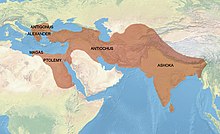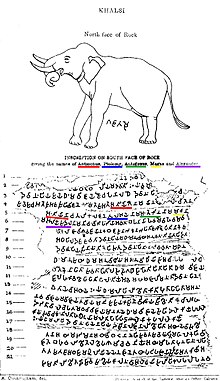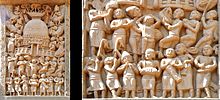Yona


The wordYonainPaliand thePrakrits,and the analogueYavanainSanskrit,were used inAncient Indiato designateGreekspeakers. "Yona" and "Yavana" are transliterations of the Greek word for "Ionians"(Ancient Greek:Ἴωνες < Ἰάoνες < *Ἰάϝoνες), who were probably the first Greeks to be known in India.
Both terms appear in ancientSanskritliterature.Yavanaappears, for instance, in theMahabharata,whileYonaappears in texts such as theSri LankanchronicleMahavamsa.
The Yona are mentioned in theAshokainscriptions, along with theKambojas,as two societies where there are only nobles and slaves.[1]
Examples of direct association of these terms with the Greeks include:
- The mention of the "Yauna" in thePersepolis Administrative Archives(550–333 BC).[2]
- The mention of the "Yona kingAṃtiyoka"in theEdicts of Ashoka(280 BCE)
- The mention of the "Yona kingAṃtalikitasa"in theHeliodorus pillarinVidisha(110 BCE)
- KingMilindaand his bodyguard of "500 Yonas" in theMilinda Panha.
- The description of Greekastrologyand Greek terminology in theYavanajātaka"Nativity of the Yavanas" (150 CE).
- The mention ofAlexandria on the Caucasus,"the city of the Yonas" in theMahavamsa,Chapter 29 (4th century CE).
In general, the words "Yoṇa" or "Yoṇaka" were the current Greek Hellenistic forms, while the term "Yavana" was the Indian word to designate theGreeksor theIndo-Greeks.[3]
Comparable terms in the ancient world
[edit]
This usage was shared by many of the countries east of Greece, from theMediterraneantoSindh:
- Egyptiansused the wordywnj-ꜥꜣ.
- InArabicit isYūnān.
- Assyriansused the wordIawanu.
- Babyloniansused the wordYamanandYamanaya.[4]
- InBiblical Hebrew,the word was יווןYāwān(Modern HebrewYavan)
- Persiansused the wordYaunafrom theOld Persianword for designating the Greeks, namely "Yauna" (literally 'Ionians', as they were the first Greeks with whom the Persians had extensive contact).[5]
- The ancientChineseexonymfor modern-dayFerghanais "Dayuan",which may come from the term Yona.
History
[edit]The usage of "Yona" and "Yavana, or variants such as" Yauna "and" Javana ", appears repeatedly, and particularly in relation to the Greek kingdoms which neighboured or sometimes occupied thePunjabover a period of several centuries from the 4th century BCE to the first century CE, such as theSeleucid Empire,theGreco-Bactrian kingdomand theIndo-Greek kingdom.[citation needed]The Yavanar are mentioned in detail inSangam literatureepics such asPaṭṭiṉappālai,describing their brisk trade with theEarly Cholasin theSangam period.
AfterAlexander the Great's invasion, the Greek settlements had existed in eastern parts ofAchaemenid Empire,northwest of India, as neighbours to theKambojas.[citation needed]The references to the Yonas in the earlyBuddhist textsmay be related to the same.[citation needed]
The Yavanas are mentioned by the grammarianPāṇini,probably in reference to their writing.[6]
Role in Buddhism
[edit]Edicts of Ashoka (250 BC)
[edit]

Some of the better-known examples are those of theEdicts of Ashoka(c. 250 BCE), in which the EmperorAshokarefers to the Greek populations under his rule. Rock Edicts V and XIII mention the Yonas (or the Greeks) along with the Kambojas and Gandharas as a subject people forming a frontier region of his empire and attest that he sent envoys to the Greek rulers in the West as far as the Mediterranean, faultlessly naming them one by one.
Inthe Gandhari original of Rock XIII,the Greek kings to the West are associated unambiguously with the term "Yona": Antiochus is referred as"Amtiyoko nama Yonaraja"(lit. "The Greek king by the name of Antiochus"), beyond whom live the four other kings:"param ca tena Atiyokena cature 4 rajani Turamaye nama Amtikini nama Maka nama Alikasudaro nama"(lit. "And beyond Antiochus, four kingsby the name of Ptolemy,the name of Antigonos,the name of Magas,the name Alexander").
In Buddhist Texts
[edit]OtherBuddhist textssuch as theDipavamsaand the 1861Sasana Vamsareveal that after theThird Buddhist council,the elder monk (thero) Maharakkhita was sent to the "Yona country" and he preached Buddhism among the Yonas and the Kambojas, and that at the same time the Yona elder monk (thero)Dharmaraksitawas sent to the country of Aparantaka inWestern Indiaalso.Ashoka's Rock Edict XIIIalso pairs the Yonas with theKambojas(Yonakambojesu) and conveys thatbrahmansandśramaṇasare found everywhere in his empire except in the lands of the Yonas and the Kambojas.
Mahavamsa
[edit]TheMahavamsaor "Great Chronicle" of Sri Lanka refers to the thera Mahārakkhita being sent to preach to the Yona country, and also to the Yona theraDhammarakkhita,who was sent toAparanta( "the Western Ends" ).[8] It also mentions thatPandukabhaya of Anuradhapuraset aside a part of hiscapital cityofAnuradhapurafor the Yonas.[9]
Another Yona thera,Mahādhammarakkhita,is mentioned as having come fromAlexandria on the Caucasusin the country of the Yonas, to be present at the building of theRuwanwelisaya.[10]
Milindapanha
[edit]Another example is that of theMilinda Panha(Chapter I), where "Yonaka" is used to refer to the greatIndo-GreekkingMenander(160–135 BC), and to the guard of "five hundred Greeks" that constantly accompanies him.
Invasion of India
[edit]TheVanaparavaofMahabharatacontains prophecies that "Mlecchakings of the Shakas, Yavanas, Kambojas, Bahlikas etc. shall rule the earth un-righteously in Kaliyuga... ".[11]This reference apparently alludes to chaotic political scenario following the collapse of theMauryaandShunga Empiresin northern India and its subsequent occupation by foreign hordes such as of the Yonas,Kambojas,SakasandPahlavas.

There are important references to the warring Mleccha hordes of the Shakas, Yavanas, Kambojas, the Pahlavas and others in theBala KandaofValmiki'sRamayana.[citation needed]
Indologists like Dr H. C. Raychadhury, Dr B. C. Law, Dr Satya Shrava and others see in these verses the clear glimpses of the struggles of the Hindus with the mixed invading hordes of the barbaric Sakas, Yavanas, Kambojas, Pahlavas etc. from north-west.[12]The time frame for these struggles is 2nd century BCE downwards.[13]
The other Indian records prophecies the 180 BCE Yona attacks onSaket,Panchala,MathuraandPataliputra,probably against the Shunga Empire, and possibly in defence of Buddhism: "After having conquered Saketa, the country of the Panchala and the Mathuras, the Yavanas, wicked and valiant, will reach Kusumadhvaja (" The town of the flower-standard ", Pataliputra). The thick mud-fortifications at Pataliputra being reached, all the provinces will be in disorder, without doubt. Ultimately, a great battle will follow, with tree-like engines (siege engines)."[14]"The Yavanas will command, the Kings will disappear. (But ultimately) the Yavanas, intoxicated with fighting, will not stay in Madhadesa (the Middle Country); there will be undoubtedly a civil war among them, arising in their own country, there will be a terrible and ferocious war."[15]The "Anushasanaparava" of theMahabharataaffirms that the country of Majjhimadesa was invaded the Yavanas and the Kambojas who were later utterly defeated. The Yona invasion of Majjhimadesa ( "middle country, midlands" ) was jointly carried out by the Yonas and the Kambojas. Majjhimadesa here means the middle of Greater India which then included Afghanistan, Pakistan and large parts of Central Asia.
Other references
[edit]On the 110 BCEHeliodorus pillarinVidishain Central India, the Indo-Greek kingAntialcidas,who had sent an ambassador to the court of the Shunga emperor Bhagabhadra, was also qualified as "Yona".
TheMahavamsaalso attests Yona settlement inAnuradhapurain ancientSri Lanka,probably contributing to trade between East and West.
Buddhist texts likeSumangala Vilasiniclass the language of the Yavanas with the Milakkhabhasa i.e.impure language.
Romantraders in Tamilakkam were also considered Yavanas.
Sanchi
[edit]
Some of the friezes ofSanchialso show devotees in Greek attire. The men are depicted with short curly hair, often held together with aheadbandof the type commonly seen onancient Greek coinage.The clothing too is Greek, complete withtunics,capes and sandals. The musical instruments are also quite characteristic, such as the double flute calledaulos.Also visible arecarnyx-likehorns.They are all celebrating at the entrance of the stupa. These men would be foreigners from north-west India visiting thestupa,possiblyMallas,Indo-Scythiansor Indo-Greeks.[16]
Three inscriptions are known from Yavana[17]donors at Sanchi, the clearest of which reads "Setapathiyasa Yonasa danam"(" Gift of the Yona of Setapatha "), Setapatha being an uncertain city.[18]
Buddhist caves of Western India
[edit]
In the GreatChaityaof theKarla Cavesbuilt and dedicated byWestern SatrapsNahapanain 120 CE,[20]there are six inscriptions made by self-described Yavana donors, who donated six of the pillars, although their names are Buddhist names.[21]They account for nearly half of the known dedicatory inscriptions on the pillars of the Chaitya.[22]
- 3rd pillar of the left row:
- 4th pillar of the left row:
- "Of Dhamma, a Yavana from Dhenukakata"[25]
- 9th pillar of the left row:
- "(This) pillar (is) the gift of the Yavana Yasavadhana from Denukakata"[19]
- 5th pillar of the right row:
- "This pillar is the gift of the Yavana Vitasamghata from Umehanakata"[26]
- 13th pillar of the right row:
- "(This) pillar (is) the gift of the Yavana Dhamadhaya from Denukakata"[27]
- 15th pillar of the right row:
- "(This) pillar (is) the gift of the Yavana Chulayakha from Dhenukakata"[28]
The city of Dhenukakata is thought to be Danahu near the city ofKarli.[21]It is described by other donors in other inscriptions as a "vaniya-gama" (A community of merchants).
The Yavanas are also known for their donation of a complete cave at theNasik Caves(cave No.17), and for their donations with inscriptions at theJunnar caves.
The Yonas and other northwestern invaders in Indian literature
[edit]The Yavanas or Yonas are frequently found listed with theKambojas,Sakas,Pahlavasand other northwestern tribes in numerous ancient Indian texts.

TheMahabharatagroups the Yavanas with the Kambojas and the Chinas and calls them "Mlechchas" (Barbarians). In the Shanti Parva section, the Yavanas are grouped with the Kambojas,Kiratas,Sakas,and thePahlavasetc. and are spoken of as living the life ofDasyus(dacoits). In another chapter of the same Parva, the Yaunas, Kambojas, Gandharas etc. are spoken of as equal to the "Svapakas" and the "Grddhras".
Udyogaparva of Mahabharata[31]says that the composite army of the Kambojas, Yavanas and Sakas had participated in the Mahabharata war under the supreme command of Kamboja kingSudakshina.Theepicnumerously applauds this composite army as being very fierce and wrathful.
Balakanda ofRamayanaalso groups the Yavanas with the Kambojas, Sakas, Pahlavas etc. and refers to them as the military allies ofsageVishistha againstVedicking Vishwamitra[32]The Kishkindha Kanda of Ramayana locates the Sakas, Kambojas, Yavanas and Paradas in the extreme north-west beyond theHimavat(i.e.Hindukush).[33]
The Buddhist dramaMudrarakshasabyVisakhaduttaas well as theJainaworksParishishtaparvanrefer toChandragupta's alliance withHimalayanking Parvataka. This Himalayan alliance gave Chandragupta a powerful composite army made up of the frontier martial tribes of the Shakas, Kambojas, Yavanas, Parasikas, Bahlikas etc.[34]which he may have utilised to aid defeat theGreeksuccessors ofAlexander the Greatand theNandarulers ofMagadha,and thus establishing hisMauryan Empirein northern India.
Manusmriti[35]lists the Yavanas with the Kambojas, Sakas, Pahlavas,Paradasetc. and regards them as degradedKshatriyas(Hindu caste). Anushasanaparva of Mahabharata[36]also views the Yavanas, Kambojas, Shakas etc. in the same light. Patanjali's Mahabhashya[37]regards the Yavanas and Sakas as Anirvasita (pure)Shudras.Gautama-Dharmasutra[38]regards the Yavanas or Greeks as having sprung from Shudra females and Kshatriya males.
The Assalayana Sutta of Majjhima Nikaya attests that in Yona and Kamboja nations, there were only two classes of people...AryasandDasas...the masters and slaves, and that the Arya could become Dasa and vice versa. The Vishnu Purana also indicates that the "Chaturvarna" or four class social system was absent in the lands of Kiratas in the East, and the Yavanas and Kambojas etc. in the West.
NumerousPuranicliterature groups the Yavanas with theSakas,Kambojas,PahlavasandParadasand refers to the peculiar hair styles of these people which were different from those of theHindus.GanapathaonPāṇiniattests that it was a practice among the Yavanas and the Kambojas to wear short-cropped hair (Kamboja-mundah Yavana-mundah).
Vartika ofKatayayanainforms us that the kings of the Shakas and the Yavanas, like those of the Kambojas, may also be addressed by their respectivetribalnames.
Brihatkathamanjari ofKshmendra[39]informs us that kingVikramadityahad unburdened the sacred earth of theBarbarianslike the Shakas, Kambojas, Yavanas, Tusharas, Parasikas, Hunas etc. by annihilating these sinners completely.
The Brahmanda Purana[40]refers to the horses born in Yavana country.
TheMahaniddesa[41]speaks of Yona and Parama Yona, probably referring toArachosiaas the Yona andBactriaas the Parama Yona.
Later meanings
[edit]
The terms "Yona", "Yonaka" or "Yavana" literally referred to theGreeks,however "mlechas" was also used probably due to their barbaric behaviour as invaders. Indian languages did not base a distinction on religion early on but after the arrival ofIslamto the subcontinent, the term Yavana was used along with Turuka, Turuska, Tajik, and Arab more than Mussalaman orMuslimfor invaders professing Islam as their religion.[43]
TheChamsofChampaare thought referringĐại Việtas "Yavana".[44][45][46][47]However this statement is largely vague. Cham sources referDai Vietasnagara Yuen(Cham:nagara yvan, lit. "Viet state" ), and the Viets asYuen(yvan).[48]Both terminologies in Cham materials were written in Cham script andOld Cam,the first dated 1142 during the reign ofHarivarman I,showing little linguistic evidence to prove that ChamYuenand IndianYavanaare connected.[49]Similarly for Kiernan's argument to KhmerYuon,the Cham reference for the Viet should have been derived from "Yue" or "Viet".
TheKhmerword "Yuon" (yuôn) យួន /yuən/ was thought to be anethnic slur for Vietnamese,derived from the Indian word for Greek, "Yavana",[50]however, it is actually the transcription of the word "Viet" or "Yueh" rather than "Yavana",[51]because the Khmer wordYuonspelled with the diphthong uo, not v in "Yavana". According to Kiernan, "thePol Pot regime,following French orientalists, mythologizedits conflict with Hanoias part of a millennial ethnic epic "; therefore they altered the meaning ofyuonthat being misleading implied assavages, foreigners.[52]
TheSinhaleseterm Yonaka referring to theSri Lankan Moors,is thought to have been derived from the term Yona.[53]
Contemporary usage
[edit]The word Yona, or one of its derivatives, is still used by some languages to designate contemporary Greece, such as in Arabic (يونان), in Hebrew (יוון), in Turkish ( "Yunanistan"), in Armenian (ՀունաստանHounistan), modernAramaic(ܝܘ̈ܢܝܐYawnoye), or the Pashto, Hindi, Urdu, Malay and Indonesian languages ( "Yunani").
See also
[edit]Notes
[edit]- ^Thomas, Edward Joseph(1933).The History of Buddhist Thought.Asian Educational Services. p. 85 with footnote 2.ISBN978-81-206-1095-8.
- ^Waters, Matt (2014).Ancient Persia: A Concise History of the Achaemenid Empire, 550–330 BCE.Cambridge: Cambridge University Press. p. 173.ISBN978-1-10700-9-608.
- ^The Greeks in Bactria and India by William Woodthorpe Tarnp.257
- ^Kinzl, Konrad H. (2010).A Companion to the Classical Greek World.John Wiley & Sons. p. 202.ISBN978-1-4443-3412-8.
- ^Roisman, Joseph; Worthington, Ian (2011).A Companion to Ancient Macedonia.John Wiley & Sons. p. 87.ISBN978-1-4443-5163-7.
- ^Lal, Shyam Bihari (2004). "Yavanas in the Ancient Indian Inscriptions".Proceedings of the Indian History Congress.65:1115–1120.ISSN2249-1937.JSTOR44144820.
- ^Kosmin, Paul J. (2014).The Land of the Elephant Kings.Harvard University Press. p. 57.ISBN9780674728820.
- ^(Mahavamsa XII)Archived20 October 2014 at theWayback Machine
- ^(Mahavamsa X)
- ^(Mahawamsa XXIX)
- ^Mahabharata 3.188.34–36.
- ^The Śakas in India, 1981, p 12, Satya Shrava; Journal, 1920, p 175, University of Calcutta. Department of Letters; India & Russia: Linguistic & Cultural Affinity, 1982, p 100, Weer Rajendra Rishi; Indological Studies, 1950, p 32, Dr B. C. Law; Political History of India from the Accession of Parikshit to the Coronation of Bimbisara, 1923, Page iii, Hemchandra Raychaudhuri; Political History of Ancient India, 1996, p 4, Raychaudhury; Indological Studies, 1950, p 4, Dr B. C. Law.
- ^Political History of Ancient India, 1996, pp 3–4.
- ^Gargi-Samhita Paragraph 5, Yuga Purana.
- ^Gargi-Samhita, Yuga Purana Chapter, No 7.
- ^"A guide to Sanchi" John Marshall. These "Greek-looking foreigners" are also described in Susan Huntington, "The art of ancient India", p. 100
- ^Purātattva, Number 8.Indian Archaeological Society. 1975. p. 188.
A reference to a Yona in the Sanchi inscriptions is also of immense value.(...) One of the inscriptions announces the gift of a Setapathia Yona, "Setapathiyasa Yonasa danam" i.e the gift of a Yona, inhabitant of Setapatha.The word Yona can't be here anything, but a Greek donor
- ^Upinder Singh (2016).The Idea of Ancient India: Essays on Religion, Politics, and Archaeology.SAGE Publications. p. 18.ISBN978-93-5150-647-8.
- ^abEpigraphia Indica Vol.18p.328 Inscription No10
- ^World Heritage Monuments and Related Edifices in India, Volume 1 ʻAlī Jāvīd, Tabassum Javeed, Algora Publishing, 2008p.42
- ^abSome Early Dynasties of South India, by Sudhakar Chattopadhyayap.83
- ^Epigraphia Indica Vol.18p.326-328and Epigraphia Indica Vol.7 [Epigraphia Indica Vol.7p.53-54
- ^Epigraphia Indica Vol.7p.53-54 Inscription No.7
- ^Problems of Ancient Indian History: New Perspectives and Perceptions, Shankar Goyal – 2001, p.104
- ^Epigraphia Indica Vol.7p.55-56 Inscription No.10and Epigraphia Indica Vol.18p.327 Inscription No.7differ on the content of this inscription. Here, Epigraphia Indica Vol.7 was chosen, as Epigraphia Indica Vol.18 only mentions an inscription similar to that of pillar No.3, a possible mixup.
- ^Epigraphia Indica Vol.18p.326 Inscription No1
- ^Epigraphia Indica Vol.18p.326 Inscription No 4
- ^Epigraphia Indica Vol.18p.327 Inscription No6
- ^Faces of Power: Alexander's Image and Hellenistic Politics by Andrew Stewartp.180
- ^D.N. Jha, "Early India: A Concise History" p.150, plate 17
- ^Mahabharata 5.19.21–23.
- ^Ramayana 55.2–3.
- ^Ramayana 43.12.
- ^See: Mudrarakshas, Act II.
- ^Manusmriti X.43–44.
- ^Mahabharata 13.33.23.
- ^Mahabhasya II.4.10.
- ^Gautama-Dharmasutra IV.21.
- ^Brihat-Katha-Manjari 10.1.285-86.
- ^Brahmanda Purana, Upodghatapada, 16–17.
- ^Mahaniddesa, pp 155, 415.
- ^Religions and Trade: Religious Formation, Transformation and Cross-Cultural Exchange between East and West, BRILL, 2013p.97 Note 97
- ^Parasher-Sen, Aloka (2004).Subordinate and marginal groups in early India.Oxford [Oxfordshire]: Oxford University Press. p. 52.ISBN0-19-566542-2.
- ^Udaya.Department of Culture and Monuments, Authority for the Protection and Management of the Region Angkor / Siem Reap. 2006. pp. 117, 118, 119.
- ^Miksic, John N.;Goh, Geok Yian; O'Connor, Sue (2011).Rethinking Cultural Resource Management in Southeast Asia: Preservation, Development, and Neglect.Anthem Press. p. 241.ISBN978-0-85728-389-4.
- ^Schafer, Edward H.(1967).The Vermilion Bird.University of California Press. p.11.GGKEY:J7QZAZWA45P.
- ^Higham, Charles(2014).Encyclopedia of Ancient Asian Civilizations.Infobase Publishing. p. 64.ISBN978-1-4381-0996-1.
- ^Golzio, Karl-Heinz (2004).Inscriptions of Campā based on the editions and translations of Abel Bergaigne, Étienne Aymonier, Louis Finot, Édouard Huber and other French scholars and of the work of R. C. Majumdar. Newly presented, with minor corrections of texts and translations, together with calculations of given dates.Shaker Verlag. pp. 199–200.
- ^Barrelon, Pierre; De Corbigny, Brossard; Lemire, Charles; Cahen, Gaston (1999).Cities of Nineteenth Century Colonial Vietnam: Hanoi, Saigon, Hue and the Champa Ruins.White Lotus Press. p. 191.ISBN978-9-74843-456-8.
- ^Post Staff (4 July 2003)."From Ionia to Vietnam".The Phnom Penh Post.
- ^Kenneth Tso and Sophal Ear (8 February 2010)."Yuon: What's in a xenonym?".The Phnom Penh Post.
- ^Ben Kiernan (2001)."Myth, nationalism and genocide"(PDF).Yale University Genocide Studies Program.
- ^Singh, Nagendra Kr; Khan, Abdul Mabud (2001).Encyclopaedia of the World Muslims: Tribes, Castes and Communities.Global Vision.ISBN9788187746102.
References
[edit]- The shape of ancient thought. Comparative Studies in Greek and Indian philosophies,by Thomas Mc Evilly (Allworth Press, New York 2002)ISBN1-58115-203-5
- Liber Genesis10:2. "Filii Iapheth: Gomer et Magog et Madai etIavanet Thubal et Mosoch et Thiras. "Nova vulgata.
